
Hürtgen Forest - Game Video
Omaha Mega Game: The Home Stretch
Turn Fifteen is now complete, putting us at three hours after H-Hour on Omaha Beach.
The game is now three-quarters over.
Waves Six, Seven, and Eight are now ashore, more or less wrapping up the first big assault landings of 1st US Infantry and 29th US Infantry Divisions (reinforced). The next big group of landings will constitute the mid-day “second assault” landings that more or less put the rest of these divisions ashore (18th Regimental Combat Team for 1st Infantry and 115th Regimental Combat Team for 29th Infantry Division).
Throughout this third hour of the invasion, the Americans continued to face very tough resistance from localized German strongpoints, even as the overall German position began to disintegrate. Furthermore, seemingly endless waves of engineers (including US Army construction engineers, combat engineers, and US Navy Beach Battalions) have opened huge gaps in German beach obstacles, minefields, and the Omaha Beach shingle. This means that follow-on waves have had very few losses coming ashore (still a handful here and there), and a much easier time getting up the bluffs through the opened draws to joined the fraying and bloodied remnants of earlier assault waves (some companies are down to a single platoons, some battalions are down to less than 120 combat effectives).
Yet even as the American position begins to solidify, off-board support is beginning to dissipate. The American air strikes have now all shot their bolt and returned to base. Eight P-47s were shot down and six damaged. Furthermore, naval gunfire support has reduced as priority targets are shifted further inland against German communication and transport routes.
“The Longest Day” … and the longest game, are by no means over yet …
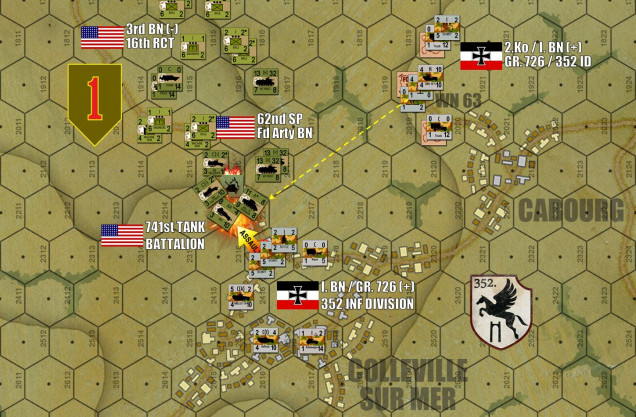 Starting off on Turn 11, the American vanguard on the far eastern wing of the battlefield runs into serious trouble. At the outskirts of Colleville sur Mer, the spearhead of what has until now been the most successful American invasion sector is knee-capped HARD by determined German “second-line” troops, including more of those damnable bicycle couriers (admittedly supported by flanking fire from multiple 2.0cm FlaK batteries). The American spearhead is thrown into chaos as Shermans and M16 AA Halftracks are pinned down, while infantry halftracks actually blow up and start burning. M7 “Priest” self-propelled howitzers are coming up to help, but they also have to deal with the fire to the flank as well as t he front. These German defenders are “older” troops, sometimes previously wounded, sick, or otherwise “second class” men. Well, they’re doing a “first class” job here. Don’t ever make fun of “Opa” again, these German grandfathers still have some kick to ‘em!
Starting off on Turn 11, the American vanguard on the far eastern wing of the battlefield runs into serious trouble. At the outskirts of Colleville sur Mer, the spearhead of what has until now been the most successful American invasion sector is knee-capped HARD by determined German “second-line” troops, including more of those damnable bicycle couriers (admittedly supported by flanking fire from multiple 2.0cm FlaK batteries). The American spearhead is thrown into chaos as Shermans and M16 AA Halftracks are pinned down, while infantry halftracks actually blow up and start burning. M7 “Priest” self-propelled howitzers are coming up to help, but they also have to deal with the fire to the flank as well as t he front. These German defenders are “older” troops, sometimes previously wounded, sick, or otherwise “second class” men. Well, they’re doing a “first class” job here. Don’t ever make fun of “Opa” again, these German grandfathers still have some kick to ‘em!  Closer to the center, the last German defenders of Wiederstandnester 65 are finally hammered into submission and then assaulted by six times their number, and even this this attack BARELY succeeded. German infantry in fortification hexes can be EXCEEDINGLY difficult to root out. But this finally completely opens the EASY ONE draw and clears the right wing of 16th RCT / 1st InfDiv.
Closer to the center, the last German defenders of Wiederstandnester 65 are finally hammered into submission and then assaulted by six times their number, and even this this attack BARELY succeeded. German infantry in fortification hexes can be EXCEEDINGLY difficult to root out. But this finally completely opens the EASY ONE draw and clears the right wing of 16th RCT / 1st InfDiv.  Almost any amphibious assault Panzer Leader game is all about the engineers. Check out the humble little D-7 bulldozer section, happily beavering away at opening he shingle along Easy Red Beach. The other bulldozer section was actually lost after a missed landing check put them right under the muzzles of a German 5.0cm antitank gun pit way over on Fox Red Beach. Remember that NO VEHICLE of any kind can enter or cross that dark brown “shingle” band until it is cleared with an “OPEN” marker. This makes the work of these D-7s, the Sherman dozers, and the engineers on foot absolutely crucial to anyone after the first wave (and this game will eventually put TEN waves ashore).
Almost any amphibious assault Panzer Leader game is all about the engineers. Check out the humble little D-7 bulldozer section, happily beavering away at opening he shingle along Easy Red Beach. The other bulldozer section was actually lost after a missed landing check put them right under the muzzles of a German 5.0cm antitank gun pit way over on Fox Red Beach. Remember that NO VEHICLE of any kind can enter or cross that dark brown “shingle” band until it is cleared with an “OPEN” marker. This makes the work of these D-7s, the Sherman dozers, and the engineers on foot absolutely crucial to anyone after the first wave (and this game will eventually put TEN waves ashore).  The town of St. Laurent was more or less the center of the German position on Omaha Beach. Here we see the forward spearheads off of 116th RCT / 29th Inf Div (3rd Battalion off of Easy Green) and 16th RCT / 1st Inf Div (2nd Battalion off of Easy Red) more or less converging from the northwest and northeast, respectively. 3/116 (Company I and L, specifically) is still engaged in a bit of a scrap against 5. Kompanie / II Bn / 916th Grenadiers along the Les Moulins road, while the 741st Tank Battalion had charged in and taken the first round of fire from desperate German 2.0cm FlaK positions. Hardly the kind of weapon you need when you’re assaulted by 47 Shermans, but it’s “stand or die” time for the Germans. The light blue “CP” marker is the overall German commander for the battlefield, and his hex is one of the 11 objectives the Americans HAVE to take. The Germans are definitely being wiped out here, but these are mostly stone and brick buildings here ... and the Americans are on the clock.
The town of St. Laurent was more or less the center of the German position on Omaha Beach. Here we see the forward spearheads off of 116th RCT / 29th Inf Div (3rd Battalion off of Easy Green) and 16th RCT / 1st Inf Div (2nd Battalion off of Easy Red) more or less converging from the northwest and northeast, respectively. 3/116 (Company I and L, specifically) is still engaged in a bit of a scrap against 5. Kompanie / II Bn / 916th Grenadiers along the Les Moulins road, while the 741st Tank Battalion had charged in and taken the first round of fire from desperate German 2.0cm FlaK positions. Hardly the kind of weapon you need when you’re assaulted by 47 Shermans, but it’s “stand or die” time for the Germans. The light blue “CP” marker is the overall German commander for the battlefield, and his hex is one of the 11 objectives the Americans HAVE to take. The Germans are definitely being wiped out here, but these are mostly stone and brick buildings here ... and the Americans are on the clock.  Turn 13 in the west ... the end in Vierville. Note the remains of 1st Battalion / 116th RCT and Company “C” / 2nd Rangers (Captain “Miller’s” unit). This is definitely the “mop up” phase, at least on this corner of the battlefield, not to mention a little bit of payback for the slaughter inflicted on these men when the first hit the beach. For comparison, 1/116 has 5 counters left of its original 20, and C/2nd Rangers has three of its original five. All the other American counters in this attack are swept up fragments of other shattered battalions or reinforcements from follow-on waves.
Turn 13 in the west ... the end in Vierville. Note the remains of 1st Battalion / 116th RCT and Company “C” / 2nd Rangers (Captain “Miller’s” unit). This is definitely the “mop up” phase, at least on this corner of the battlefield, not to mention a little bit of payback for the slaughter inflicted on these men when the first hit the beach. For comparison, 1/116 has 5 counters left of its original 20, and C/2nd Rangers has three of its original five. All the other American counters in this attack are swept up fragments of other shattered battalions or reinforcements from follow-on waves. 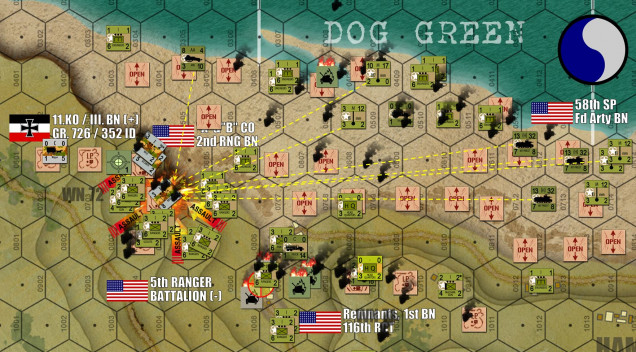 Turn 14, and Wiederstandnester 72 (the furthest one to the west) simply won’t die. Part of the problem here is the terrain, the steep cliffs facing the beach (dark brown line) preclude any assault, narrowing thr frontage available to 5th Rangers and Able and Baker Companies / 2nd Rangers. But now a full BATTALION (three batteries, or 18 guns) of 105mm M7 “Priest” self-propelled howitzers are positively unloading on this bunker, as well as four batteries of battalion mortars plus the regiment’s battery of 4.2 inch “chemical” (white phosphorus) mortars. In all, 48 pieces of artillery blasting away over open sights at this thing, and still an assault of 440 troops (including rangers and combat engineers) cannot take it down. The Germans are NOT going gently into that good night.
Turn 14, and Wiederstandnester 72 (the furthest one to the west) simply won’t die. Part of the problem here is the terrain, the steep cliffs facing the beach (dark brown line) preclude any assault, narrowing thr frontage available to 5th Rangers and Able and Baker Companies / 2nd Rangers. But now a full BATTALION (three batteries, or 18 guns) of 105mm M7 “Priest” self-propelled howitzers are positively unloading on this bunker, as well as four batteries of battalion mortars plus the regiment’s battery of 4.2 inch “chemical” (white phosphorus) mortars. In all, 48 pieces of artillery blasting away over open sights at this thing, and still an assault of 440 troops (including rangers and combat engineers) cannot take it down. The Germans are NOT going gently into that good night. As the Les Moulins Road is cleared, and the Shermans of 741st Tank Battalion shatter the right wing of the St. Laurent position, the Germans here seem more or less doomed. But the Americans get a little cocky with their 7th wave artillery, and even as they’re being destroyed, German FlaK batteries manage to pick off two batteries of American 75mm howizters as they’re dragged into position by soft-skinned “DUKW” amphibious trucks. That’s four more American platoons added to an already shocking casualty count (even higher than the historical battle actually). The Germans may be going down, but they are going down swinging.
As the Les Moulins Road is cleared, and the Shermans of 741st Tank Battalion shatter the right wing of the St. Laurent position, the Germans here seem more or less doomed. But the Americans get a little cocky with their 7th wave artillery, and even as they’re being destroyed, German FlaK batteries manage to pick off two batteries of American 75mm howizters as they’re dragged into position by soft-skinned “DUKW” amphibious trucks. That’s four more American platoons added to an already shocking casualty count (even higher than the historical battle actually). The Germans may be going down, but they are going down swinging. 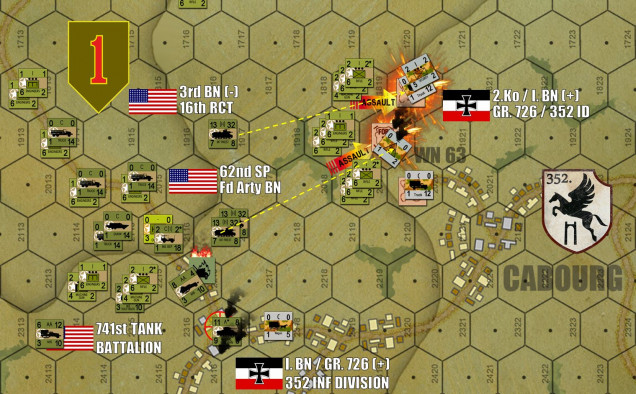 Still on Turn 14, on the far eastern edge of the board, the end for Wiederstandnester 63. It takes self-propelled artillery a little bit of time to get into position (62nd Self-Propelled Field Artillery Battalion, attached to 16/1st InfDiv), but once they do they are a virtual blowtorch burning holes wherever they can reach (and they can reach a loooong way). Meanwhile, the heroic “Opa” company in the northern outskirts of Colleville have been overwhelmed. That Sherman platoon at lower left moves in to occupy that objective town hex.
Still on Turn 14, on the far eastern edge of the board, the end for Wiederstandnester 63. It takes self-propelled artillery a little bit of time to get into position (62nd Self-Propelled Field Artillery Battalion, attached to 16/1st InfDiv), but once they do they are a virtual blowtorch burning holes wherever they can reach (and they can reach a loooong way). Meanwhile, the heroic “Opa” company in the northern outskirts of Colleville have been overwhelmed. That Sherman platoon at lower left moves in to occupy that objective town hex. 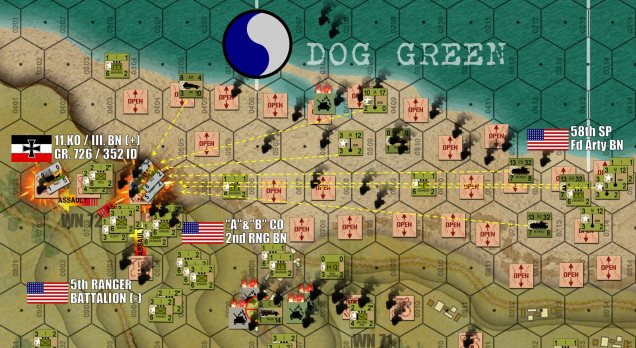 Turn 15, Wiederstandnester 72 FINALLY goes down. At last, the guns fall silent over the carnage, wreckage, and devastation of Dog Green Beach. It’s been three hours. Historically it was more like FIVE OR SIX hours. It definitely wasn’t the twenty minutes or so we see in Saving Private Ryan. Every smoke marker is an eliminated platoon, but please remember at least a third of these are German, especially to the south. Still, the American cost here has been ghastly. But with more tanks actually making it ashore in this game than made it historically, and more immediate air and naval support committed to this sector, things could have gone far, far worse (again, historically this took 5-6 hours, or up to 30 Panzer Leader turns).
Turn 15, Wiederstandnester 72 FINALLY goes down. At last, the guns fall silent over the carnage, wreckage, and devastation of Dog Green Beach. It’s been three hours. Historically it was more like FIVE OR SIX hours. It definitely wasn’t the twenty minutes or so we see in Saving Private Ryan. Every smoke marker is an eliminated platoon, but please remember at least a third of these are German, especially to the south. Still, the American cost here has been ghastly. But with more tanks actually making it ashore in this game than made it historically, and more immediate air and naval support committed to this sector, things could have gone far, far worse (again, historically this took 5-6 hours, or up to 30 Panzer Leader turns). 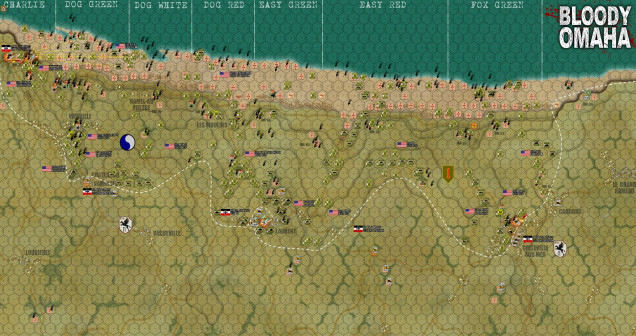 H+180, three hours in. American gains in the center and east more or less match the historical result (not quite 1.5 miles at their deepest points, about 3/4 of a mile at their shallowest), but American gains in the west are much better. Over all, however, the Americans have paid for this accelerated pace of advance with a higher casualty count. TWO objective hexes remain in German hands (including that stubborn little pocket in St. Laurent) but they’ll be giving up the ghost very quickly. I won’t lie, the Germans are probably going to be tabled here. Almost 300 American counters have been put on the table at one time or another, and only about 15 German counters remain (one WN strongpoint remains to the extreme east, just under the “BLOODY OMAHA” logo) It’s all about getting off that beach. As long as you’re ON THE BEACH, pre-sited German artillery and fortified machine guns will tear you to shreds. Once you’re up on the bluff, however, the “slaughter shoe” immediately shifts to the other foot.
H+180, three hours in. American gains in the center and east more or less match the historical result (not quite 1.5 miles at their deepest points, about 3/4 of a mile at their shallowest), but American gains in the west are much better. Over all, however, the Americans have paid for this accelerated pace of advance with a higher casualty count. TWO objective hexes remain in German hands (including that stubborn little pocket in St. Laurent) but they’ll be giving up the ghost very quickly. I won’t lie, the Germans are probably going to be tabled here. Almost 300 American counters have been put on the table at one time or another, and only about 15 German counters remain (one WN strongpoint remains to the extreme east, just under the “BLOODY OMAHA” logo) It’s all about getting off that beach. As long as you’re ON THE BEACH, pre-sited German artillery and fortified machine guns will tear you to shreds. Once you’re up on the bluff, however, the “slaughter shoe” immediately shifts to the other foot. 






























![How To Paint Moonstone’s Nanny | Goblin King Games [7 Days Early Access]](https://images.beastsofwar.com/2024/12/3CU-Gobin-King-Games-Moonstone-Shades-Nanny-coverimage-225-127.jpg)








































Reading this as I wait for the local Independence Day Fireworks to begin.
Wonderful news that the Americans are pushing in and unleashing their brand of hell on the Germans.
For the record I’ve ridden in a DUKW on land and in the water, but can’t even imagine what that ride would be like under fire!
Thanks, @templar007 – our fireworks finished off about three hours ago. Yeah, those DUKWs shouldn’t ever have been “under fire” – with an unarmored DF of 1 they’re not really meant to take any enemy attention. I just got careless and forgot how far those German FlaK batteries could fire, and how that slope was shaped (i.e., how LOS was configured). The Germans in St. Laurent knew they were going down that turn, so I had them take a vindictive swipe and basically shoot up 2/3 of an American artillery battalion (any unit carried in or limbered behind a transport… Read more »